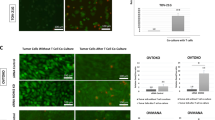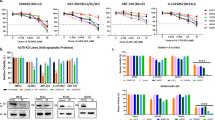Abstract
Dacarbazine (DTIC) is one of the most popular alkylating agents used for the treatment of malignant melanoma. DTIC induces apoptosis of melanoma cells via double-strand breaks (DSBs). Melanoma cells, however, tend to increase their expression of DNA repair molecules in order to be resistant to DTIC. Here, we show that DTIC increases expression of Rad51, but not Ku70, in a cultured B16-F10 mouse melanoma cell line in dose- and time-dependent manners. On introducing Rad51 short interfering RNA (siRNA) with the hemagglutinating virus of Japan envelope (HVJ-E) to B16-F10 cells, DSBs induced by DTIC treatment were not efficiently repaired and resulted in enhanced apoptotic cell death. Colony formation of B16-F10 cells that received Rad51 siRNA was significantly decreased by DTIC treatment as compared with cells that received scramble siRNA. In melanoma-bearing mice, the combination of three intratumoral injections of HVJ-E containing Rad51 siRNA and five intraperitoneal injections of DTIC at a clinical dose synergistically suppressed the tumors. Moreover, HVJ-E demonstrated anti-tumor immunity by inducing cytotoxic T lymphocytes to B16-F10 cells on administration of DTIC. These results suggest that the combination of chemotherapy with HVJ-E containing therapeutic molecules will provide a promising therapeutic strategy for patients bearing malignant tumors resistant to chemotherapeutic agents.
This is a preview of subscription content, access via your institution
Access options
Subscribe to this journal
Receive 12 print issues and online access
$259.00 per year
only $21.58 per issue
Buy this article
- Purchase on Springer Link
- Instant access to full article PDF
Prices may be subject to local taxes which are calculated during checkout





Similar content being viewed by others
References
Atkins MB, Buzaid AC, Houghton AN . Systemic chemotherapy and biochemotherapy. In: Balch CM et al. (eds). Cutaneous Melanoma, 4th edn. Quality Medical Publishing: St Louis, 2003, pp 589–604.
Chapman PB, Einhorn LH, Meyers ML, Saxman S, Destro AN, Panageas KS et al. Phase III multicenter randomized trial of the Dartmouth regimen versus dacarbazine in patients with metastatic melanoma. J Clin Oncol 1999; 17: 2745–2751.
Huncharek M, Caubet JF, McGarry R . Single-agent DTIC versus combination chemotherapy with or without immunotherapy in metastatic melanoma: a meta-analysis of 3273 patients from 20 randomized trials. Melanoma Res 2001; 11: 75–81.
Tom C, Reg F, Bernadette C, Malcolm M . Systemic treatments for metastatic cutaneous melanoma. Cochrane Database Syst Rev 2000; 2: CD001215.
Peter B, Stephen CW . Role of the human RAD51 protein in homologous recombination and double-stranded-break repair. Trends Biochem Sci 1998; 23: 247–251.
Maacke H, Jost K, Opitz S, Miska S, Yuan Y, Hasselbach L et al. DNA repair and recombination factor Rad51 is over-expressed in human pancreatic adenocarcinoma. Oncogene 2000; 19: 2791–2795.
John T . The Rad51 gene family, genetic instability and cancer. Cancer Lett 2005; 219: 125–135.
Makoto I, Seiji Y, Keisuke N, Kazuya H, Hiraoka K, Tamai K et al. Rad51 siRNA delivered by HVJ envelope vector enhances the anti-cancer effect of cisplatin. J Gene Med 2005; 7: 1044–1052.
Jonathan AFH, Juehui L, Zhu QS, Bolshakov SV, Li L, Pisters PW et al. Rad51 overexpression contributes to chemoresistance in human soft tissue sarcoma cells: a role for p53/activator protein 2 transcriptional regulation. Mol Cancer Ther 2007; 6: 1651–1659.
Elke R, Karen S, Susanne F, Vanessa S, Schweiger S, Haaf T et al. Elevated levels of Rad51 recombination protein in tumor cells. Cancer Res 2002; 62: 219–225.
Kondo Y, Fushikida K, Fujieda T, Sakai K, Miyata K, Kato F et al. Efficient delivery of antibody into living cells using a novel HVJ envelope vector system. J Immunol Meth 2008; 332: 10–17.
Kaneda Y, Nakajima T, Nishikawa T, Yamamoto S, Ikegami H, Suzuki N et al. Hemagglutinating virus of Japan (HVJ) envelope vector as a versatile gene delivery system. Mol Ther 2002; 6: 219–226.
Takami Y, Nakagami H, Morishita R, Katsuya T, Cui TX, Ichikawa T et al. Ubiquitin carboxy-terminal hydrolase L1, a novel deubiquitinating enzyme in the vasculature, attenuates NF-κB activation. Arterioscler Thromb Vasc Biol 2007; 27: 2184–2190.
Kurooka M, Kaneda Y . Inactivated Sendai virus particles eradicate tumors by inducing immune responses through blocking regulatory T cells. Cancer Res 2007; 67: 227–236.
Fujuhara A, Kurooka M, Miki T, Kaneda Y . Intratumoral injection of inactivated Sendai virus particles elicits strong antitumor activity by enhancing local CXCL10 expression and systemic NK cell activation. Cancer Immunol Immunother 2008; 57: 73–84.
Matsuda M, Yamamoto T, Matsumura A, Kaneda Y . Highly efficient eradication of intracranial glioblastoma using Eg5 siRNA combined with HVJ envelope. Gene Therapy 2009; 16: 1465–1476.
Emmy PR, Duane RP, Ann HO, Ivanova VS, Bonner WM . DNA double-strand breaks induce histone H2AX phosphorylation on serine 139. J Biol Chem 1998; 273: 5858–5868.
Thomas S, Sarah AW, Karen C, Goodarzi AA, Petermann E, Concannon P et al. ATR-dependent phosphorylation and activation of ATM in response to UV treatment or replication fork stalling. EMBO 2006; 25: 5775–5782.
Ashby JM, Xuetong S . DNA repair in the context of chromatin. Cell Cycle 2005; 4: 568–571.
Christoph H, Barbara P, Christiane T, Winter D, Fink D, Kovacic B et al. Clusterin regulates drug-resistance in melanoma cells. J Invest Dermatol 2005; 124: 1300–1307.
Emma B, Derek JR, Bin-Bing SZ, Kum KK . Recent advances in cancer therapy targeting proteins involved in DNA double-strand break repair. Clin Cancer Res 2009; 15: 6314–6320.
Nicola JC . PARP inhibitors for cancer therapy. Expert Rev Mol Med 2005; 15: 603–617.
Christopher MH, Andrei S, Vera G . Use of the Rad51 promoter for targeted anti-cancer therapy. Proc Natl Acad Sci USA 2008; 105: 20810–20815.
Jen-Chung K, Shih-Ci C, Chau-Ming C, Wang LH, Hong JH, Jheng MY et al. Involvement of Rad51 in cytotoxicity induced by epidermal growth factor receptor inhibitor (gefitinib, IressaR) and chemotherapeutic agents in human lung cancer cells. Carcinogenesis 2008; 29: 1448–1458.
Artur S, Christoph S, Gregory T, Nieborowska-Skorska M, Hoser G, Nowicki MO et al. BCR/ABL regulates mammalian RecA homologs, resulting in drug resistance. Mol Cell 2001; 8: 795–806.
Jeffery SR, Kristin B, William EB, Cerra MA, Oswaid KA, Camphausen K et al. Gleevec-mediated inhibition of Rad51 expression and enhancement of tumor cell radiosensitivity. Cancer Res 2003; 63: 7377–7383.
Roman T, kerstin F, John T, Kaina B . Xrcc2 deficiency sensitizes cells to apoptosis by MNNG and the alkylating anticancer drugs temozolomide, fotemustine and mafosfamide. Cancer Lett 2006; 239: 305–313.
Bolderson E, Richard DJ, Zhou BBS, Khanna KK . Recent advances in cancer therapy targeting proteins involved in DNA double-strand break repair. Clin Cancer Res 2009; 15: 6314–6320.
Eric W, David JC . The endless tale of non-homologous end-joining. Cell Res 2008; 18: 114–124.
Olszewska-Slonina DM, Styczynisk J, Drewa TA, Olszewski KJ, Czajkowski R . B16 and cloudman S91 mouse melanoma cells susceptibility to apoptosis after dacarbazine treatment. Acta Pol Pharm 2005; 62: 473–483.
Min H, Ze-Hong M, Hong Z, Yu-Jun C, Wei L, Jian D . Chk1 and Chk2 are differentially involved in homologous recombination repair and cell cycle arrest in response to DNA double-strand breaks induced by camptothecins. Mol Cancer Ther 2008; 7: 1440–1449.
Kim J, Kim PH, Yoo JY, Yoon AR, Choi HJ, Seong J et al. Double E1B 19kDa- and E1B 55 kDa-deleted oncolytic adenovirus in combination with radiotherapy elicits an enhanced anti-tumor effect. Gene Therapy 2009; 16: 1111–1121.
Atkins MB, Hsu J, Lee S, Cohen GI, Flaherty LE, Sosman JA et al. Phase III trial comparing concurrent biochemotherapy with cisplatin, vinblastine, dacarbazine, interleukin-2, and interferon alfa-2b with cisplatin, vinblastine, and dacarbazine alone in patients with metastatic malignant melanoma (E3695): a trial coordinated by the Eastern Cooperative Oncology Group. J Clin Oncol 2008; 26: 5748–5754.
Masayuki S, Masumi H, Yasumitsu T, Takano TY, Nakatsu Y, Tsuzuki T et al. Modes of actions of two types of anti-neoplastic drugs, dacarbazine and ACNU, to induce apoptosis. Carcinogenesis 2007; 28: 2657–2663.
Saga K, Tamai K, Kawachi M, Shimbo T, Fujita H, Yamazaki T et al. Functional modification of Sendai virus by siRNA. J Biotechnol 2008; 133: 386–394.
Acknowledgements
This work was supported by the Northern Osaka (Saito) Biomedical Knowledge-Based Cluster Creation Project, Scientific Research (B) Fund by the Ministry of Education, Culture, Sports, Science and Technology of Japan and grants from the Ministry of Health, Labor, and Welfare of Japan.
Author information
Authors and Affiliations
Corresponding author
Ethics declarations
Competing interests
The authors declare no conflict of interest.
Additional information
Supplementary Information accompanies the paper on Gene Therapy website
Supplementary information
Rights and permissions
About this article
Cite this article
Kiyohara, E., Tamai, K., Katayama, I. et al. The combination of chemotherapy with HVJ-E containing Rad51 siRNA elicited diverse anti-tumor effects and synergistically suppressed melanoma. Gene Ther 19, 734–741 (2012). https://doi.org/10.1038/gt.2011.123
Received:
Revised:
Accepted:
Published:
Issue Date:
DOI: https://doi.org/10.1038/gt.2011.123
Keywords
This article is cited by
-
Intratumoral injection of hemagglutinating virus of Japan-envelope vector yielded an antitumor effect for advanced melanoma: a phase I/IIa clinical study
Cancer Immunology, Immunotherapy (2020)
-
miR-98-5p contributes to cisplatin resistance in epithelial ovarian cancer by suppressing miR-152 biogenesis via targeting Dicer1
Cell Death & Disease (2018)



